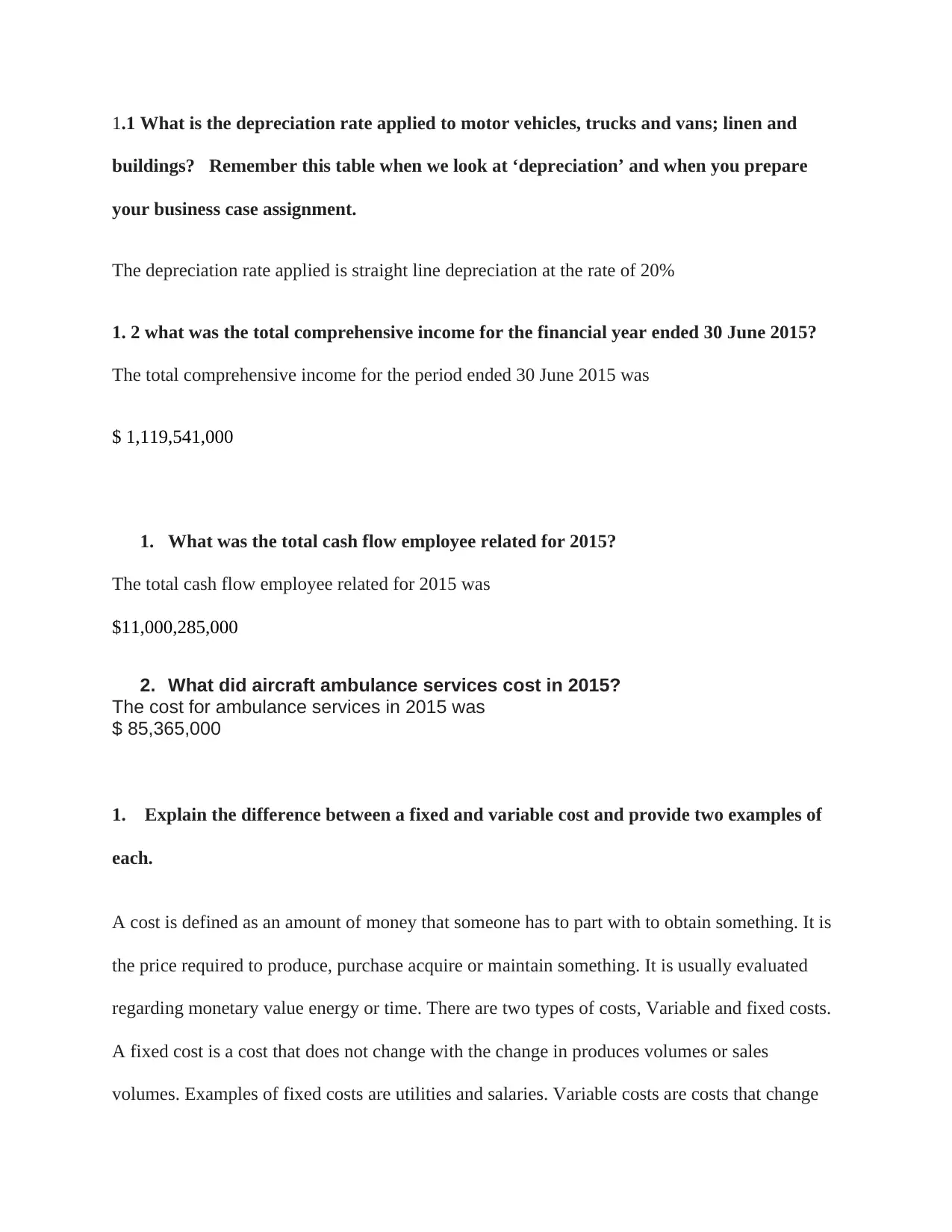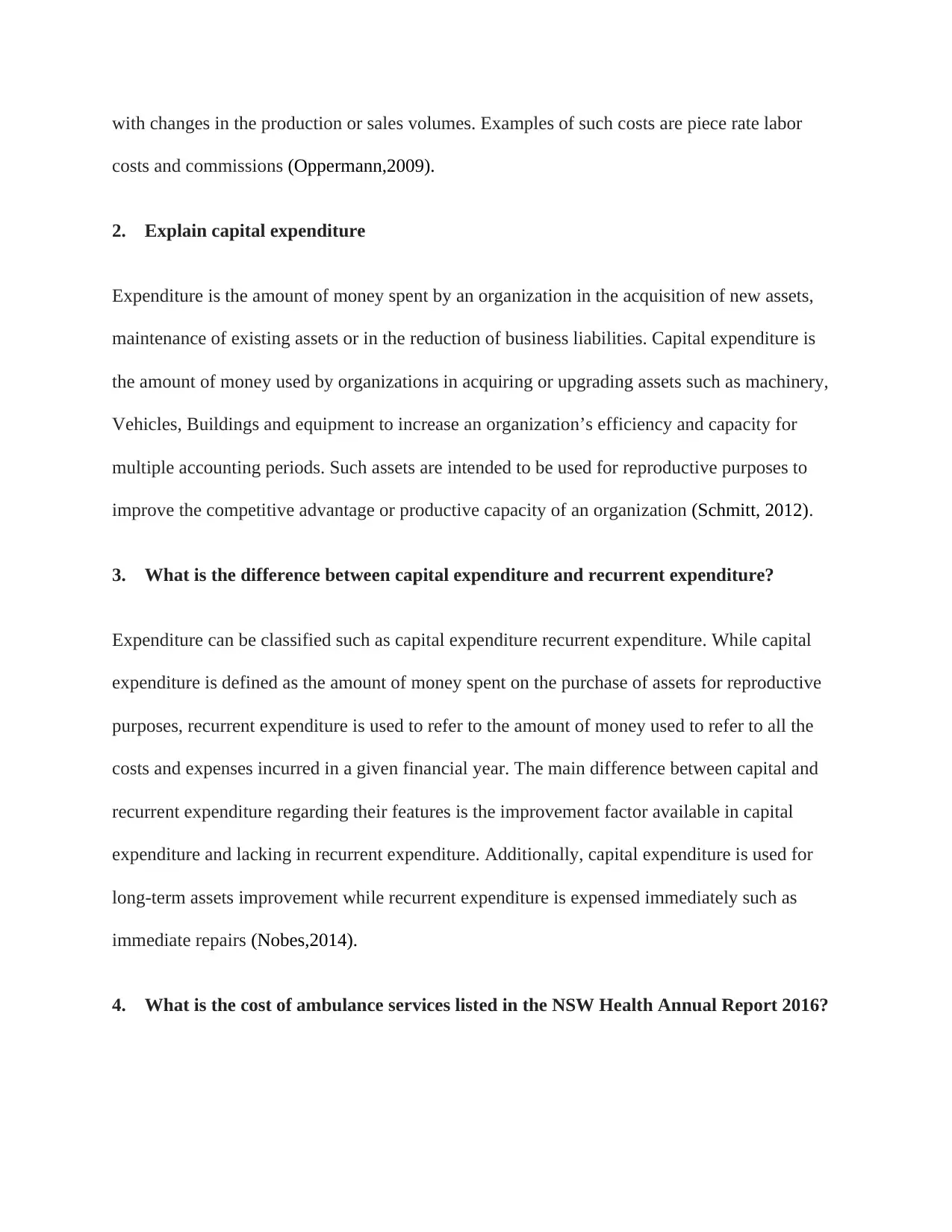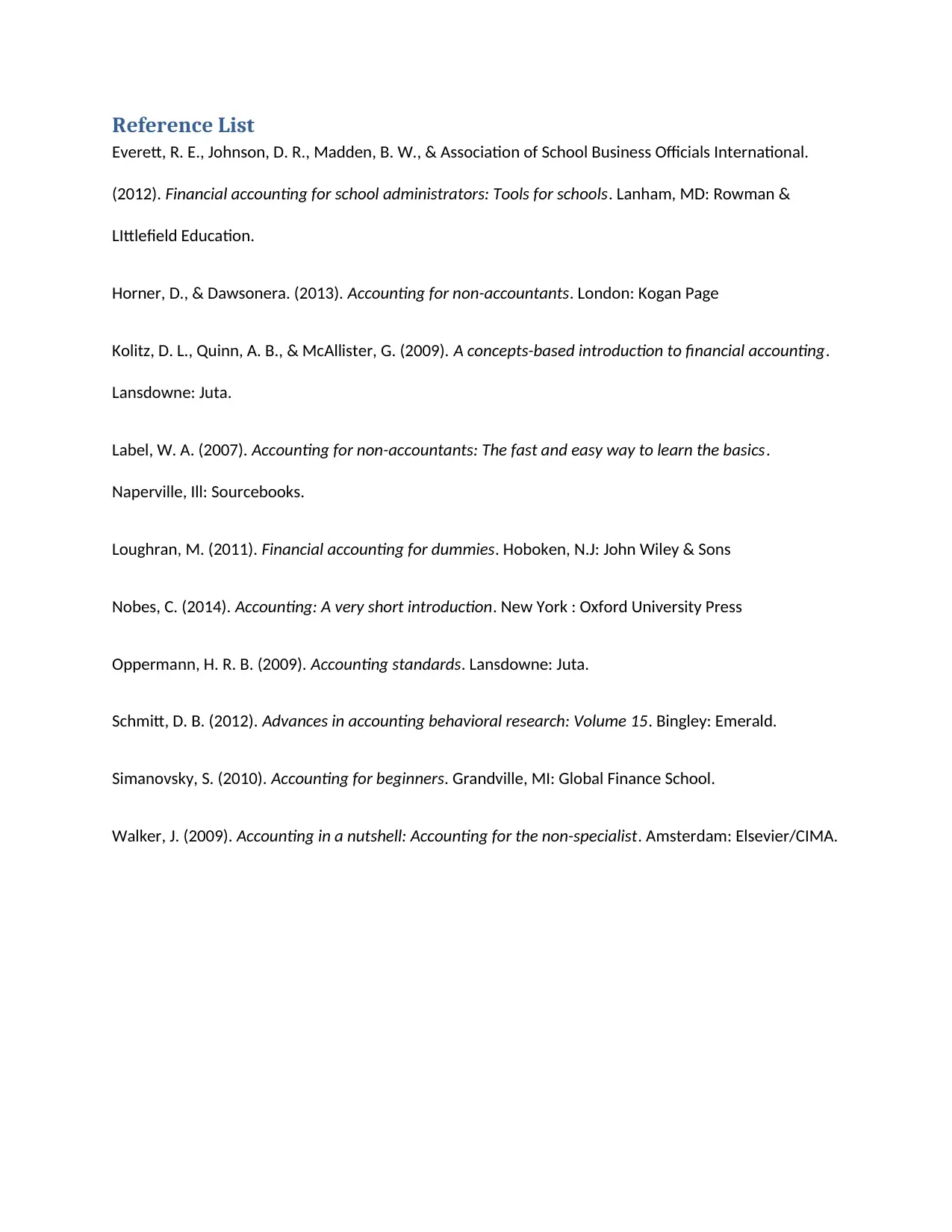Accounting Module Questions and Answers - Finance Assignment
VerifiedAdded on 2020/05/04
|7
|1334
|55
Homework Assignment
AI Summary
This document provides a comprehensive overview of accounting concepts and financial analysis. It answers specific questions related to depreciation rates, comprehensive income, cash flow, and ambulance service costs. The document explains the difference between fixed and variable costs, providing examples for each. It also clarifies capital expenditure and recurrent expenditure, highlighting their differences and implications. Furthermore, the document addresses the financial aspects of public hospitals, business cases, and grant applications, emphasizing their importance and distinctions. Detailed explanations of each concept are provided, along with references to relevant sources, offering a complete and insightful analysis of the accounting module questions.

Accounting Module Questions
Institutional Affiliation
Name
Date
Institutional Affiliation
Name
Date
Paraphrase This Document
Need a fresh take? Get an instant paraphrase of this document with our AI Paraphraser


1.1 What is the depreciation rate applied to motor vehicles, trucks and vans; linen and
buildings? Remember this table when we look at ‘depreciation’ and when you prepare
your business case assignment.
The depreciation rate applied is straight line depreciation at the rate of 20%
1. 2 what was the total comprehensive income for the financial year ended 30 June 2015?
The total comprehensive income for the period ended 30 June 2015 was
$ 1,119,541,000
1. What was the total cash flow employee related for 2015?
The total cash flow employee related for 2015 was
$11,000,285,000
2. What did aircraft ambulance services cost in 2015?
The cost for ambulance services in 2015 was
$ 85,365,000
1. Explain the difference between a fixed and variable cost and provide two examples of
each.
A cost is defined as an amount of money that someone has to part with to obtain something. It is
the price required to produce, purchase acquire or maintain something. It is usually evaluated
regarding monetary value energy or time. There are two types of costs, Variable and fixed costs.
A fixed cost is a cost that does not change with the change in produces volumes or sales
volumes. Examples of fixed costs are utilities and salaries. Variable costs are costs that change
buildings? Remember this table when we look at ‘depreciation’ and when you prepare
your business case assignment.
The depreciation rate applied is straight line depreciation at the rate of 20%
1. 2 what was the total comprehensive income for the financial year ended 30 June 2015?
The total comprehensive income for the period ended 30 June 2015 was
$ 1,119,541,000
1. What was the total cash flow employee related for 2015?
The total cash flow employee related for 2015 was
$11,000,285,000
2. What did aircraft ambulance services cost in 2015?
The cost for ambulance services in 2015 was
$ 85,365,000
1. Explain the difference between a fixed and variable cost and provide two examples of
each.
A cost is defined as an amount of money that someone has to part with to obtain something. It is
the price required to produce, purchase acquire or maintain something. It is usually evaluated
regarding monetary value energy or time. There are two types of costs, Variable and fixed costs.
A fixed cost is a cost that does not change with the change in produces volumes or sales
volumes. Examples of fixed costs are utilities and salaries. Variable costs are costs that change
⊘ This is a preview!⊘
Do you want full access?
Subscribe today to unlock all pages.

Trusted by 1+ million students worldwide

with changes in the production or sales volumes. Examples of such costs are piece rate labor
costs and commissions (Oppermann,2009).
2. Explain capital expenditure
Expenditure is the amount of money spent by an organization in the acquisition of new assets,
maintenance of existing assets or in the reduction of business liabilities. Capital expenditure is
the amount of money used by organizations in acquiring or upgrading assets such as machinery,
Vehicles, Buildings and equipment to increase an organization’s efficiency and capacity for
multiple accounting periods. Such assets are intended to be used for reproductive purposes to
improve the competitive advantage or productive capacity of an organization (Schmitt, 2012).
3. What is the difference between capital expenditure and recurrent expenditure?
Expenditure can be classified such as capital expenditure recurrent expenditure. While capital
expenditure is defined as the amount of money spent on the purchase of assets for reproductive
purposes, recurrent expenditure is used to refer to the amount of money used to refer to all the
costs and expenses incurred in a given financial year. The main difference between capital and
recurrent expenditure regarding their features is the improvement factor available in capital
expenditure and lacking in recurrent expenditure. Additionally, capital expenditure is used for
long-term assets improvement while recurrent expenditure is expensed immediately such as
immediate repairs (Nobes,2014).
4. What is the cost of ambulance services listed in the NSW Health Annual Report 2016?
costs and commissions (Oppermann,2009).
2. Explain capital expenditure
Expenditure is the amount of money spent by an organization in the acquisition of new assets,
maintenance of existing assets or in the reduction of business liabilities. Capital expenditure is
the amount of money used by organizations in acquiring or upgrading assets such as machinery,
Vehicles, Buildings and equipment to increase an organization’s efficiency and capacity for
multiple accounting periods. Such assets are intended to be used for reproductive purposes to
improve the competitive advantage or productive capacity of an organization (Schmitt, 2012).
3. What is the difference between capital expenditure and recurrent expenditure?
Expenditure can be classified such as capital expenditure recurrent expenditure. While capital
expenditure is defined as the amount of money spent on the purchase of assets for reproductive
purposes, recurrent expenditure is used to refer to the amount of money used to refer to all the
costs and expenses incurred in a given financial year. The main difference between capital and
recurrent expenditure regarding their features is the improvement factor available in capital
expenditure and lacking in recurrent expenditure. Additionally, capital expenditure is used for
long-term assets improvement while recurrent expenditure is expensed immediately such as
immediate repairs (Nobes,2014).
4. What is the cost of ambulance services listed in the NSW Health Annual Report 2016?
Paraphrase This Document
Need a fresh take? Get an instant paraphrase of this document with our AI Paraphraser

New SOUTH Wales Ambulance is Health Ministry agency funded by the New South Wales
Government, tasked with the responsibility of providing ambulance services and pre-hospital
emergency care in the New South Wales state. The cost of ambulance services listed in NSW
Annual report 2016 are in the category of recurrent expenditure because it does not result in
acquisition the of new ambulances but is aimed at facilitating the operation of NSW ambulance
in pre-hospital emergency care and ambulance services (Loughran,2011).
5. Public hospitals do not make a profit so what happens when they cannot break even,
eg, too many, patients or insufficient operating costs?
Public hospitals are hospitals owned by a Government. A public hospital can also be referred to
as a government hospital. The main source of income for public hospitals is the government.
Many of such hospitals provide services for free or at a smaller fee that is affordable to the
majority. In an instance where such hospitals fail to break even, or in instances where their
demand for their services is too much, or their operating costs are insufficient, public hospitals
are reimbursed by the Government (Label,2007).
1. Why are Business cases so important?
A business case is a description of business opportunity at hand, possible solutions and the one
that was picked, the problems that can be solved by the project, period for recovering costs and
making profits and how businesses are going to make money through the project (Walker,2009).
The main importance of business cases is that they explain the viability of a given project and
help an organization to decide on whether to invest money in a project or not. They also facilitate
internal budget approval and strategy prioritization. Business cases are also important because
Government, tasked with the responsibility of providing ambulance services and pre-hospital
emergency care in the New South Wales state. The cost of ambulance services listed in NSW
Annual report 2016 are in the category of recurrent expenditure because it does not result in
acquisition the of new ambulances but is aimed at facilitating the operation of NSW ambulance
in pre-hospital emergency care and ambulance services (Loughran,2011).
5. Public hospitals do not make a profit so what happens when they cannot break even,
eg, too many, patients or insufficient operating costs?
Public hospitals are hospitals owned by a Government. A public hospital can also be referred to
as a government hospital. The main source of income for public hospitals is the government.
Many of such hospitals provide services for free or at a smaller fee that is affordable to the
majority. In an instance where such hospitals fail to break even, or in instances where their
demand for their services is too much, or their operating costs are insufficient, public hospitals
are reimbursed by the Government (Label,2007).
1. Why are Business cases so important?
A business case is a description of business opportunity at hand, possible solutions and the one
that was picked, the problems that can be solved by the project, period for recovering costs and
making profits and how businesses are going to make money through the project (Walker,2009).
The main importance of business cases is that they explain the viability of a given project and
help an organization to decide on whether to invest money in a project or not. They also facilitate
internal budget approval and strategy prioritization. Business cases are also important because

they help decision makers to improve the intended courses of action (Kolitz, Quinn &
McAllister, 2009).
2. What are the implications when a business case is not funded?
Failure to fund a business case would mean that potential opportunity that would have been
exploited by the business case remains unexploited, which would deny an organization an
opportunity to generate profits from the project. Additionally, failure to fund a business case
would mean that potential challenges facing an organization which would have been addressed
by the implementation of the project at hand would remain within an organization and continue
to affect it (Horner & Dawsonera, 2013).
3. How are grant applications different from business cases?
Grants refer to a non-repayable amount of money or goods given to individuals, businesses, non-
profit organizations or educational institutions. Such funds are usually provided by institutions
such as corporations, government department, trust or foundations after completion of a provided
funding application process (Simanovsky, 2010). Grants usually involve some conditions on
usage and maintenance. An organization or individual must check if they meet the eligibility
criteria before submitting their application. The applicant must, therefore, register as grant
applicants with the responsible government department or corporation, Fill and then submit a
grant application package. This is unlike a business case which does not involve any eligibility
and can be either oral or written (Everett, et al, 2012)
McAllister, 2009).
2. What are the implications when a business case is not funded?
Failure to fund a business case would mean that potential opportunity that would have been
exploited by the business case remains unexploited, which would deny an organization an
opportunity to generate profits from the project. Additionally, failure to fund a business case
would mean that potential challenges facing an organization which would have been addressed
by the implementation of the project at hand would remain within an organization and continue
to affect it (Horner & Dawsonera, 2013).
3. How are grant applications different from business cases?
Grants refer to a non-repayable amount of money or goods given to individuals, businesses, non-
profit organizations or educational institutions. Such funds are usually provided by institutions
such as corporations, government department, trust or foundations after completion of a provided
funding application process (Simanovsky, 2010). Grants usually involve some conditions on
usage and maintenance. An organization or individual must check if they meet the eligibility
criteria before submitting their application. The applicant must, therefore, register as grant
applicants with the responsible government department or corporation, Fill and then submit a
grant application package. This is unlike a business case which does not involve any eligibility
and can be either oral or written (Everett, et al, 2012)
⊘ This is a preview!⊘
Do you want full access?
Subscribe today to unlock all pages.

Trusted by 1+ million students worldwide

Reference List
Everett, R. E., Johnson, D. R., Madden, B. W., & Association of School Business Officials International.
(2012). Financial accounting for school administrators: Tools for schools. Lanham, MD: Rowman &
LIttlefield Education.
Horner, D., & Dawsonera. (2013). Accounting for non-accountants. London: Kogan Page
Kolitz, D. L., Quinn, A. B., & McAllister, G. (2009). A concepts-based introduction to financial accounting.
Lansdowne: Juta.
Label, W. A. (2007). Accounting for non-accountants: The fast and easy way to learn the basics.
Naperville, Ill: Sourcebooks.
Loughran, M. (2011). Financial accounting for dummies. Hoboken, N.J: John Wiley & Sons
Nobes, C. (2014). Accounting: A very short introduction. New York : Oxford University Press
Oppermann, H. R. B. (2009). Accounting standards. Lansdowne: Juta.
Schmitt, D. B. (2012). Advances in accounting behavioral research: Volume 15. Bingley: Emerald.
Simanovsky, S. (2010). Accounting for beginners. Grandville, MI: Global Finance School.
Walker, J. (2009). Accounting in a nutshell: Accounting for the non-specialist. Amsterdam: Elsevier/CIMA.
Everett, R. E., Johnson, D. R., Madden, B. W., & Association of School Business Officials International.
(2012). Financial accounting for school administrators: Tools for schools. Lanham, MD: Rowman &
LIttlefield Education.
Horner, D., & Dawsonera. (2013). Accounting for non-accountants. London: Kogan Page
Kolitz, D. L., Quinn, A. B., & McAllister, G. (2009). A concepts-based introduction to financial accounting.
Lansdowne: Juta.
Label, W. A. (2007). Accounting for non-accountants: The fast and easy way to learn the basics.
Naperville, Ill: Sourcebooks.
Loughran, M. (2011). Financial accounting for dummies. Hoboken, N.J: John Wiley & Sons
Nobes, C. (2014). Accounting: A very short introduction. New York : Oxford University Press
Oppermann, H. R. B. (2009). Accounting standards. Lansdowne: Juta.
Schmitt, D. B. (2012). Advances in accounting behavioral research: Volume 15. Bingley: Emerald.
Simanovsky, S. (2010). Accounting for beginners. Grandville, MI: Global Finance School.
Walker, J. (2009). Accounting in a nutshell: Accounting for the non-specialist. Amsterdam: Elsevier/CIMA.
1 out of 7
Your All-in-One AI-Powered Toolkit for Academic Success.
+13062052269
info@desklib.com
Available 24*7 on WhatsApp / Email
![[object Object]](/_next/static/media/star-bottom.7253800d.svg)
Unlock your academic potential
Copyright © 2020–2025 A2Z Services. All Rights Reserved. Developed and managed by ZUCOL.